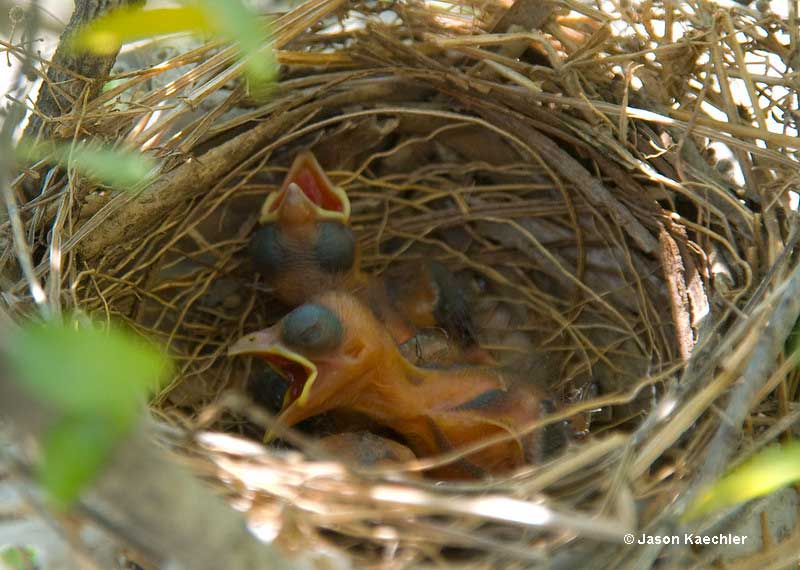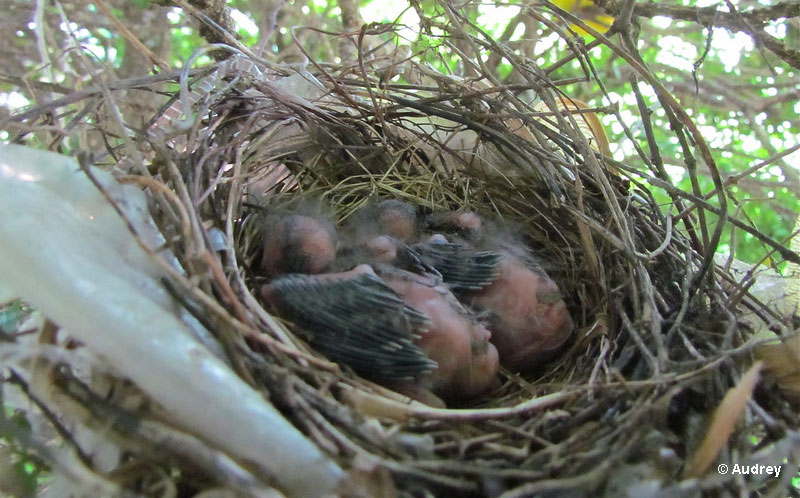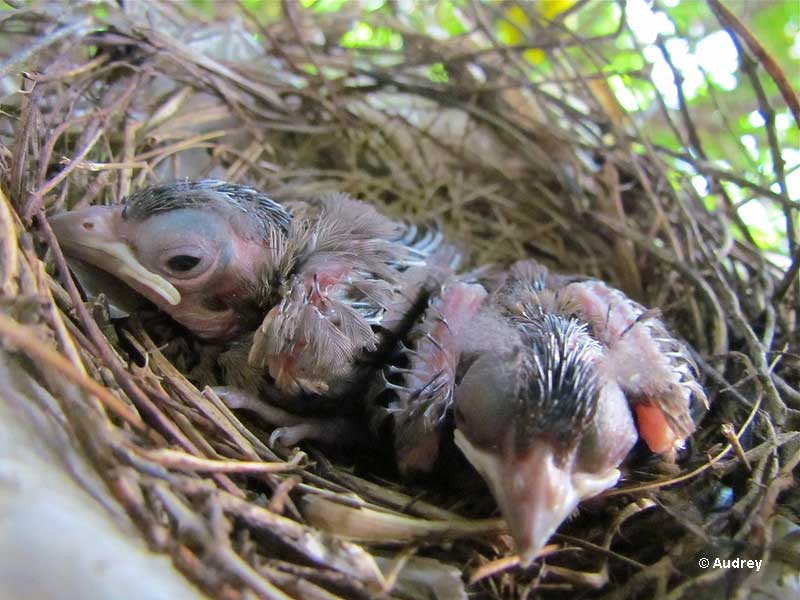
Cardinals are known for their red plumage and fierce behavior, but that’s not the case with their young.
Baby cardinals hatch as tiny, naked, and completely helpless birds. Although they grow fast, baby cardinals still have a few challenges to face.
Keep reading to find out what makes the first few weeks of their life so special!
On this page
Nest
The female Northern Cardinal builds a cup-shaped nest in a shrub or small tree, often in a dense thicket or vine tangle, and usually five to six feet above the ground. The nest is made of four distinct layers and is placed in the fork of twigs or branches.
The mother cardinal builds it with bark, stems, grasses, vines, and other bits of vegetation, using larger twigs for the outer layer, grapevine bark for the next layer, and then puts a layer of leaves under a nest lining of soft grass. The size of cardinal nests varies, but on average, they have a height of 2.6 inches, a depth of 1.4 inches, and a diameter of 4.25 inches.
Two to five eggs are laid and incubated by the female for around two weeks. The eggs are oval, weigh 4.9 grams on average, and can be pale green, cream, or buff with gray or brown marks and speckling.
Upon hatching, the baby cardinals are naked, helpless, and the only movement they can make is that of opening their mouths.
Related: Do cardinals mate for life?
However, they grow quickly and usually leave the nest just nine or ten days after hatching. While they are growing, baby cardinals don’t move much, but when the parents arrive, they immediately stretch their necks up, open their mouths to receive food, and make high-pitched begging calls.
What Does a Baby Cardinal Look Like?
At first, a baby cardinal doesn’t look anything like its beautiful red, black, and gray parents.
After hatching, it lacks adult feathers but has some gray, fuzzy down feathering, doesn’t even open its eyes, and is very small. These tiny birds only weigh 3.5 grams, about as much as a 1/4 teaspoon of sugar, or a penny!
The hatchling birds have transparent skin with a yellowish coloration, and the only other color they show is when they open their mouths to receive food. The inside of the mouth is a bright orange-red with yellow at the edges. These colors may encourage and help adults to feed them better.
However, baby cardinals grow fast, and after a few days, they have bits of gray feathers growing in on various parts of their bodies. By the time they leave the nest, although the babies still lack the red colors of their parents, they are covered in soft feathers and even show a short tail and a hint of a crest.
For the next two weeks, they spend most of their time hiding in dense vegetation and catching their own food while still being occasionally fed by parents. After two weeks, most young cardinals are about the same size as an adult, even if they have gray instead of orange or red feathers.
How to Tell Baby Cardinals Apart?
In the nest, baby cardinals look like most other young songbirds. They lack the colors and structure we use to identify adults and, therefore, can only be identified by the structure of the nest and seeing adult birds visit and attend the young.
However, once the young birds depart the nest, they can be identified by their gray coloration, crest, and finch-like bill. They can also make a chip note that sounds like the adult, and are found in the same habitat; dense shrubbery and second growth.
Eventually, the young cardinals grow a medium-length tail and attain a brownish plumage with dull red highlights.
What Do Baby Cardinals Eat?
Baby cardinals are hungry little birds that start feeding shortly after hatching. They can be fed two, five, or even eight times per hour and large broods can be fed even more frequently.
Related: What do baby birds eat?
To help them grow and leave the nest as soon as they can, the feeding rate for baby cardinals also goes up as the baby birds get bigger. Both parents are kept busy feeding their babies throughout the day.
Although adult birds feed on seeds and fruit quite often, to provide babies with high levels of protein needed for growth, they only feed their babies insects and other small creatures.
Nestling cardinals are fed a wide variety of insects, probably just about any insect that the adult can catch. These include beetles, grasshoppers, mantises, butterflies, moths, katydids, dragonflies, cicadas, and other species. In addition to insects, cardinals sometimes bring snails and small mollusks to their young.
Food can be regurgitated and fed to the babies, but bugs are usually mashed up or broken into pieces which are then placed into the waiting mouths of the baby birds.
Frequently Asked Questions
What does a baby cardinal look like?
Baby cardinals are tiny, mostly naked and helpless birds with a dusting of soft gray feathers. When they leave the nest, the baby birds have gray feathers, short tails, and a short crest.
How long do baby cardinals stay with their parents?
From the time they hatch, baby cardinals stay with their parents in the nest for around ten days. After leaving the nest, their parents occasionally feed them for anywhere from 25 days to eight weeks.
How long does it take for a baby cardinal to turn red?
It can be a year before baby cardinals turn as red as their parents.
What time of year are baby cardinals born?
Baby cardinals are born in the spring, in April and May.
Is the Northern Cardinal the state bird of any states?
Northern Cardinal happens to be a state bird for 7 states: Illinois, Indiana, Kentucky, North Carolina, Ohio, Virginia and West Virginia




Janet
Sunday 16th of July 2023
We found a baby cardinal on our farm. It kept going towards the fire. When we moved it away from the fire our dog went after it. I have been feeding it moistened dog kibble. It is doing well. It can fly. It calls to be fed, about 3 x's an hour until sunset. I do not know how to prepare it to be let go. What would you suggest?
Patrick O'Donnell
Tuesday 18th of July 2023
@Janet- Good thing you saved that baby cardinal from the fire and your dog! When we find a baby bird, the best thing to do is to put it in a shrub or low tree near where you found it.
In all likelihood, its parents are close by. Sometimes, like the bird on your farm, we do need to save the baby bird from hazards like roads, pets, or other things. However, after saving it, if the baby bird has feathers and can fly, we should put it back into the wild as soon as possible.
Preferably, we should release the bird near its nest but if we don't know where the nest is, the next best thing is to release the baby bird in the closest suitable vegetation. In your case, that might be the edge of some woods or bushes far enough from the house to keep pets from attacking the baby.
The bird will still call and beg for food but its parents should be nearby and should find and feed it.